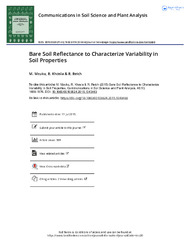| dc.contributor.author | Mzuku, M. | |
| dc.contributor.author | Khosla, R. | |
| dc.contributor.author | Reich, R. | |
| dc.date.accessioned | 2021-03-29T09:27:16Z | |
| dc.date.available | 2021-03-29T09:27:16Z | |
| dc.date.issued | 2015-07-11 | |
| dc.identifier.citation | Mzuku, M., Khosla, R., & Reich, R. (2015). Bare soil reflectance to characterize variability in soil properties. Communications in Soil Science and Plant Analysis, 46(13), 1668-1676. | en_US |
| dc.identifier.issn | 1532-2416 | |
| dc.identifier.uri | https://www.tandfonline.com/doi/full/10.1080/00103624.2015.1043463 | |
| dc.identifier.uri | https://researchhub.buan.ac.bw:80/handle/123456789/26 | |
| dc.description.abstract | Remote sensing allows for the rapid and inexpensive acquisition of soil reflectance data. Knowing what soil parameters have the greatest influence on bare soil imagery will facilitate better use of remote sensing for precision crop management. The objectives of this study were (i) to determine measured soil properties that are most influential on remotely sensed bare soil reflectance and (ii) to select which spectral band or combination of spectral bands is best for describing individual soil properties. This study was conducted on three study sites located in northeastern Colorado. All sites were in irrigated continuous corn (Zea mays L.) cropping systems. Remotely sensed imagery was acquired by aircraft prior to planting. Soil samples were collected and analyzed for bulk density, soil color (moist and dry), organic matter, organic carbon, soil texture, and cone index. Principal component analysis (PCA) was performed for the green, red, and near-infrared (NIR) bands of the imagery. Least-squares regression analysis was used for analyzing relationships between remote sensing data and soil data. Across study sites, the first principal components of the green, red, and NIR bands were found to have significant statistical relationships with organic carbon and sand, silt, and clay fractions. Individual spectral bands explained a significant portion of the variability in soil moisture, moist soil color, dry soil color, organic carbon, sand, silt, and clay. Results from this study support the use of remote sensing for assessment of soil variability. | en_US |
| dc.language.iso | en | en_US |
| dc.publisher | Taylor & Francis Online | en_US |
| dc.relation.ispartofseries | Communications in Soil Science and Plant Analysis;Vol. 46 (13), 2015, 1668-1676. | |
| dc.subject | Bare soil | en_US |
| dc.subject | Reflectance | en_US |
| dc.subject | Variability | en_US |
| dc.title | Bare soil reflectance to characterize variability in soil properties | en_US |
| dc.type | Article | en_US |

